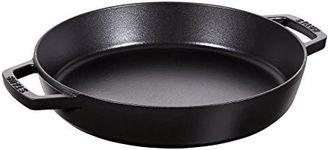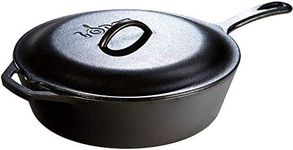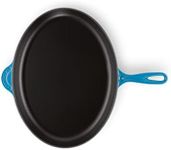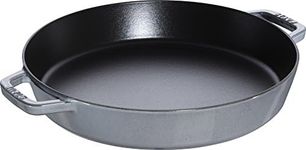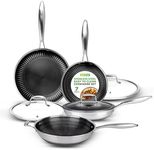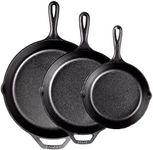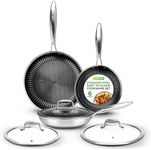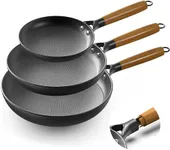Buying Guide for the Best Large Cast Iron Skillets
Choosing the right large cast iron skillet can significantly enhance your cooking experience. Cast iron skillets are known for their durability, heat retention, and versatility. They can be used for a variety of cooking methods, including frying, baking, searing, and even grilling. When selecting a large cast iron skillet, it's important to consider several key specifications to ensure it meets your cooking needs and preferences.SizeThe size of a cast iron skillet is typically measured by its diameter. This spec is important because it determines how much food you can cook at once. Skillets usually range from 10 to 15 inches in diameter. A 10-12 inch skillet is suitable for small families or individuals, while a 13-15 inch skillet is better for larger families or those who entertain often. Consider the size of your stovetop and oven, as well as your storage space, when choosing the right size for you.
WeightCast iron skillets are known for being heavy, which helps with heat retention and even cooking. However, the weight can vary significantly between different skillets. Lighter skillets (around 5-7 pounds) are easier to handle and maneuver, making them a good choice for those who may have difficulty lifting heavy objects. Heavier skillets (8 pounds and above) offer better heat retention and are less likely to move around on the stovetop, which can be beneficial for certain cooking techniques. Consider your own strength and comfort level when choosing the weight of your skillet.
Pre-seasoningPre-seasoning refers to the layer of oil that is baked onto the skillet by the manufacturer to create a non-stick surface. This spec is important because it affects the skillet's performance and ease of use. Skillets that come pre-seasoned are ready to use right out of the box and require less maintenance initially. If you prefer to season the skillet yourself, you can opt for an unseasoned skillet. Consider your willingness to maintain the seasoning and your cooking habits when deciding on pre-seasoning.
Handle DesignThe handle design of a cast iron skillet can impact its usability and comfort. Some skillets have a single long handle, while others have an additional helper handle on the opposite side. A long handle provides better leverage and control, while a helper handle makes it easier to lift and move the skillet, especially when it's full. If you plan to use the skillet for heavy dishes or in the oven, a skillet with a helper handle might be more convenient. Consider how you will be using the skillet and your comfort with handling it when choosing the handle design.
Pour SpoutsPour spouts are small notches on the sides of the skillet that allow for easy pouring of liquids. This spec is important for tasks like draining fat or transferring sauces. Skillets with pour spouts can make these tasks less messy and more precise. If you frequently cook dishes that involve liquids, a skillet with pour spouts can be very useful. Consider your cooking habits and whether you often need to pour liquids from the skillet when deciding on this feature.
Compatibility with Heat SourcesCast iron skillets are generally compatible with a variety of heat sources, including gas, electric, induction, and even open flames. This spec is important because it determines where you can use the skillet. If you have an induction cooktop, make sure the skillet is induction-compatible. If you plan to use the skillet for camping or outdoor cooking, ensure it can withstand open flames. Consider your cooking environment and the heat sources you have available when choosing a skillet.





